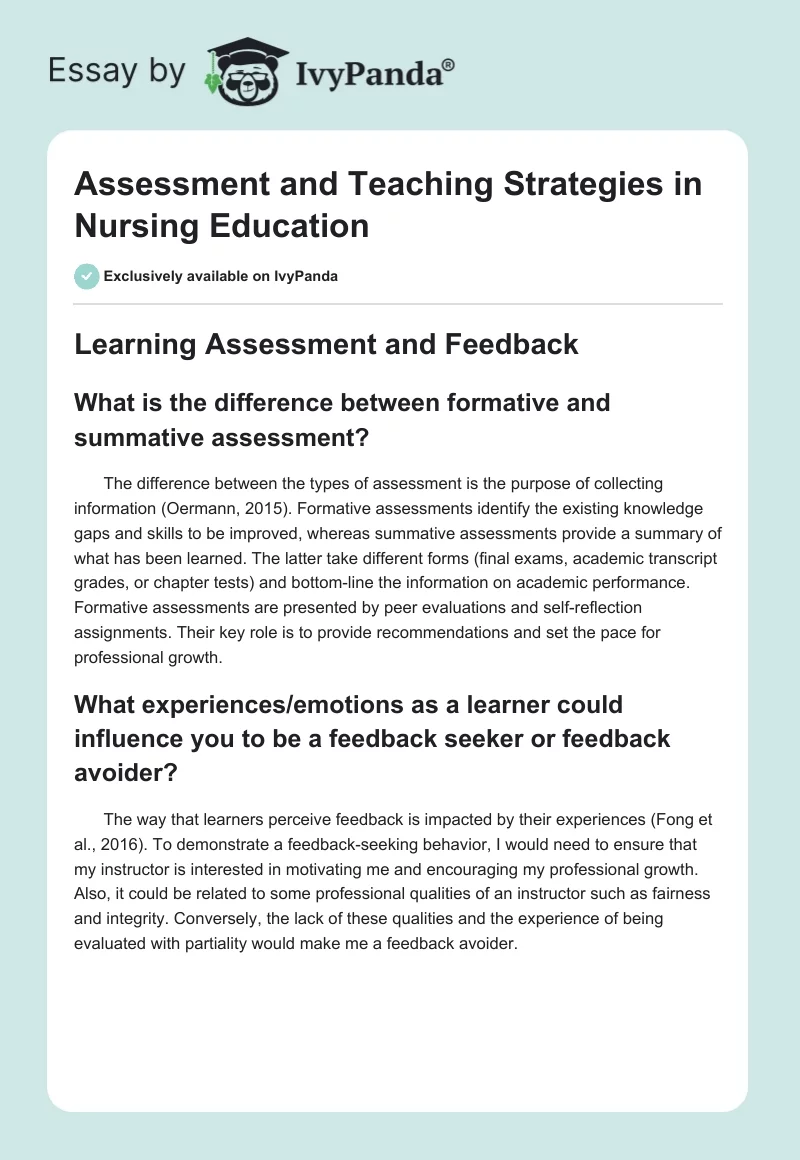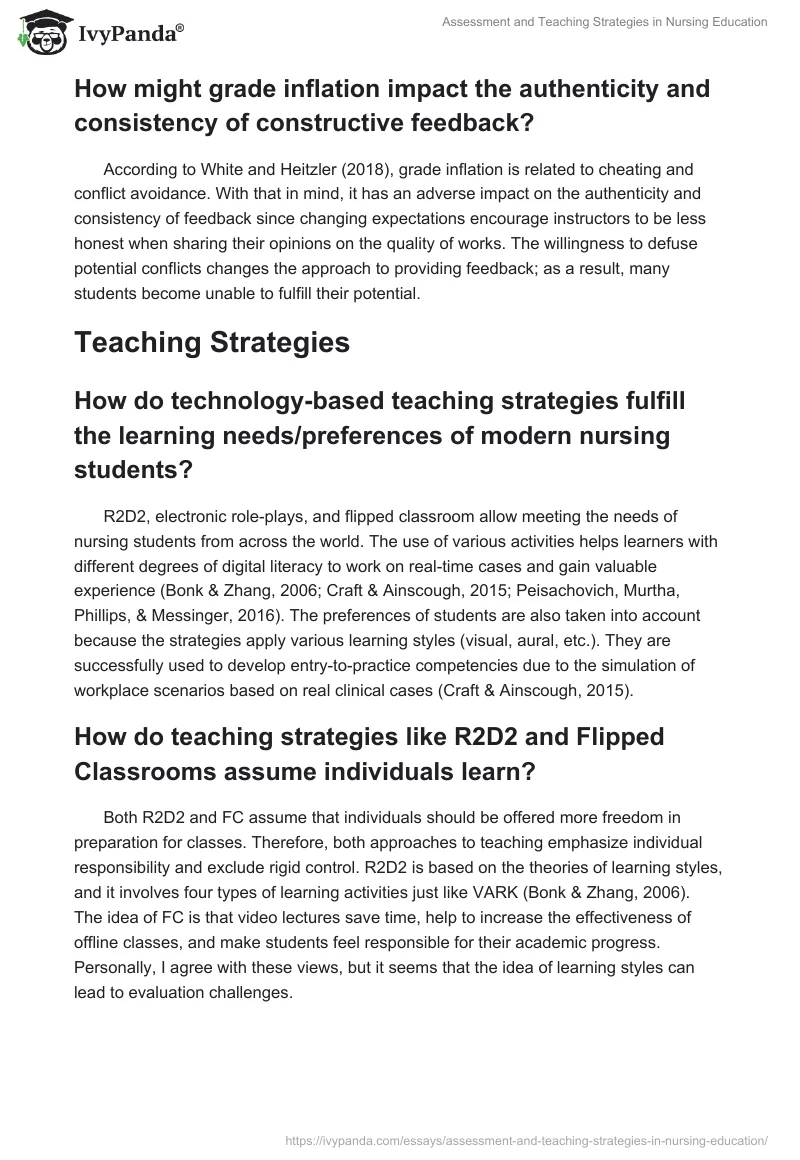Learning Assessment and Feedback
What is the difference between formative and summative assessment?
The difference between the types of assessment is the purpose of collecting information (Oermann, 2015). Formative assessments identify the existing knowledge gaps and skills to be improved, whereas summative assessments provide a summary of what has been learned. The latter take different forms (final exams, academic transcript grades, or chapter tests) and bottom-line the information on academic performance. Formative assessments are presented by peer evaluations and self-reflection assignments. Their key role is to provide recommendations and set the pace for professional growth.
What experiences/emotions as a learner could influence you to be a feedback seeker or feedback avoider?
The way that learners perceive feedback is impacted by their experiences (Fong et al., 2016). To demonstrate a feedback-seeking behavior, I would need to ensure that my instructor is interested in motivating me and encouraging my professional growth. Also, it could be related to some professional qualities of an instructor such as fairness and integrity. Conversely, the lack of these qualities and the experience of being evaluated with partiality would make me a feedback avoider.
How might grade inflation impact the authenticity and consistency of constructive feedback?
According to White and Heitzler (2018), grade inflation is related to cheating and conflict avoidance. With that in mind, it has an adverse impact on the authenticity and consistency of feedback since changing expectations encourage instructors to be less honest when sharing their opinions on the quality of works. The willingness to defuse potential conflicts changes the approach to providing feedback; as a result, many students become unable to fulfill their potential.
Teaching Strategies
How do technology-based teaching strategies fulfill the learning needs/preferences of modern nursing students?
R2D2, electronic role-plays, and flipped classroom allow meeting the needs of nursing students from across the world. The use of various activities helps learners with different degrees of digital literacy to work on real-time cases and gain valuable experience (Bonk & Zhang, 2006; Craft & Ainscough, 2015; Peisachovich, Murtha, Phillips, & Messinger, 2016). The preferences of students are also taken into account because the strategies apply various learning styles (visual, aural, etc.). They are successfully used to develop entry-to-practice competencies due to the simulation of workplace scenarios based on real clinical cases (Craft & Ainscough, 2015).
How do teaching strategies like R2D2 and Flipped Classrooms assume individuals learn?
Both R2D2 and FC assume that individuals should be offered more freedom in preparation for classes. Therefore, both approaches to teaching emphasize individual responsibility and exclude rigid control. R2D2 is based on the theories of learning styles, and it involves four types of learning activities just like VARK (Bonk & Zhang, 2006). The idea of FC is that video lectures save time, help to increase the effectiveness of offline classes, and make students feel responsible for their academic progress. Personally, I agree with these views, but it seems that the idea of learning styles can lead to evaluation challenges.
Are current teaching strategies adequately equipping undergraduate nursing students for the workplace?
Mennenga and Smyer (2010) claim that the majority of teaching strategies in nursing education are poorly structured and do not prepare nurses for work. I think that the problem is the necessity to combine different activities properly. To me, the use of only one model is unlikely to encourage well-rounded professional development. For instance, it would not be right to replace all practices with the team-based learning model since its implementation is time-consuming and requires a lot of classroom space (Mennenga & Smyer, 2010).
How can novice instructors be better supported to improve their teaching practice?
According to Scanlan (2001), many instructors are likely to use their own learning experience to teach others. To support novice teachers, it is necessary to expand their perspective on a regular basis and prevent them from using techniques ignorant of cultural diversity, individual differences, and preferred learning styles. From my experience, young instructors become successful when they rely on the clarity of explanations and establish trust-based relationships with students.
What are some of your favorite teaching methods and why do you like them?
Teaching methods that I prefer include discussions, brainstorming activities, and role plays. To me, the exchange of experience is among the most valuable sources of new knowledge, and all mentioned methods involve it. To some extent, such activities contribute to students’ future professional development. They teach future nurses to work together for a common end and feel responsible for the success of their team, and it explains their effectiveness.
References
Bonk, C. J., & Zhang, K. (2006). Introducing the R2D2 model: Online learning for the diverse learners of this world. Distance Education, 27(2), 249-264. Web.
Craft, J., & Ainscough, L. (2015). Development of an electronic role-play assessment initiative in bioscience for nursing students. Innovations in Education and Teaching International, 52(2), 172-184. Web.
Fong, C. J., Warner, J. R., Williams, K. M., Schallert, D. L., Chen, L. Williamson, Z. H. & Lin, S. (2016). Deconstructing constructive criticism: The nature of academic emotions associated with constructive positive and negative feedback. Learning and Individual Difference, 49(1), 393-399. Web.
Mennenga, H., & Smyer, T. (2010). A model for easily incorporating team-based learning into nursing education. International Journal of Nursing Education Scholarship, 7(1), 1-14.
Oermann, M. H. (2015). Assessment methods. In M. H. Oermann (Ed.), Teaching in nursing and role of the educator: The complete guide to best practice in teaching, evaluation and curriculum development (pp. 191-215). New York, NY: Springer.
Peisachovich, E. H., Murtha, S., Phillips, A., & Messinger, G. (2016). Flipping the classroom: A pedagogical approach to applying clinical judgment by engaging, interacting, and collaborating with nursing students. International Journal of Higher Education, 5(4), 114-121.
Scanlan, J. M. (2001). Learning clinical teaching: Is it magic? Nursing and Health Care Perspectives, 22(5), 240-246.
White, K. A., & Heitzler, E. T. (2018). Effect of increased evaluation objectivity on grade inflation: Precise grading rubrics and rigorously developed tests. Nurse Educator, 43(2), 73-77. Web.


